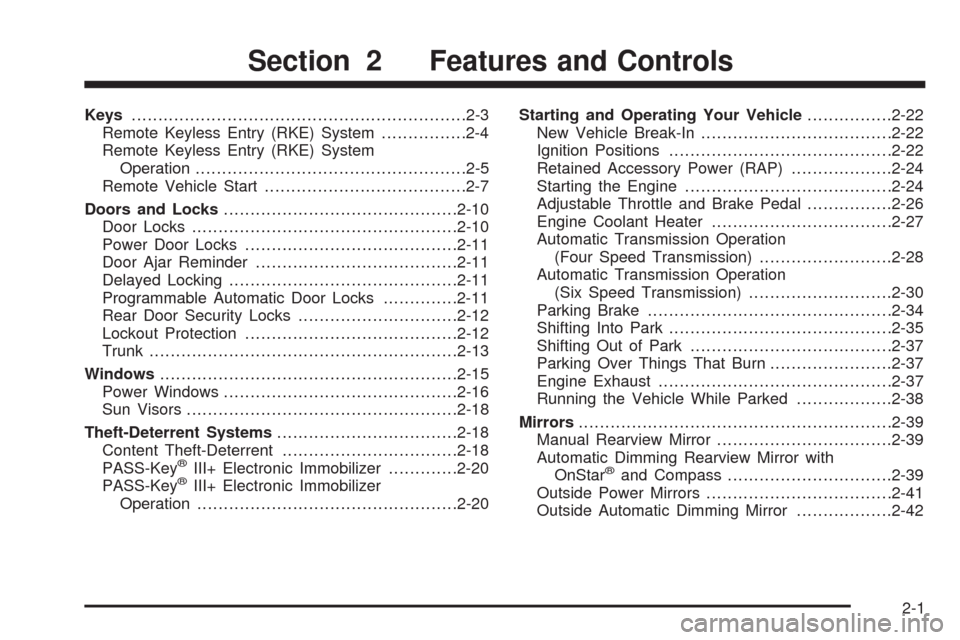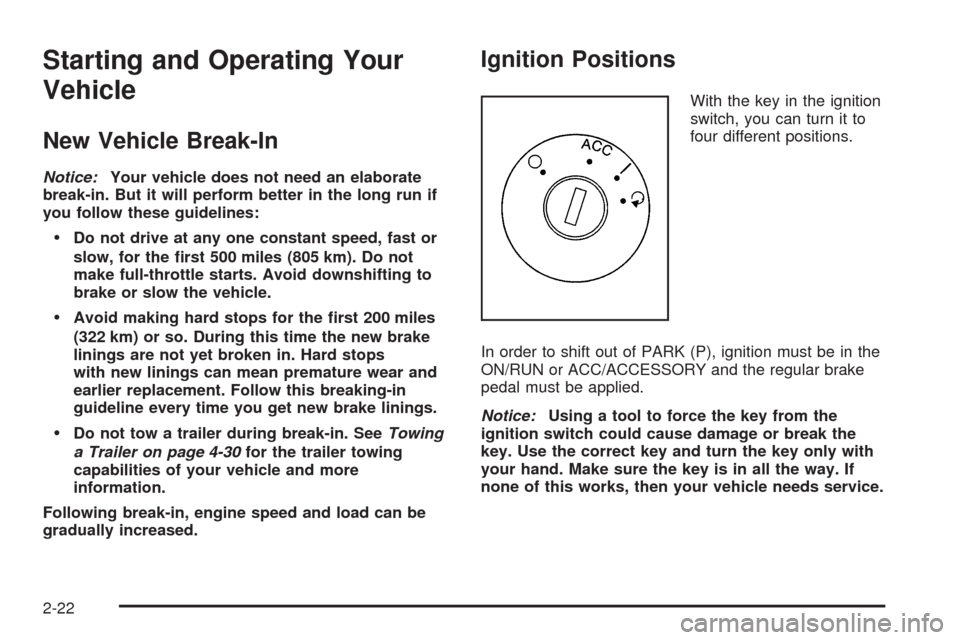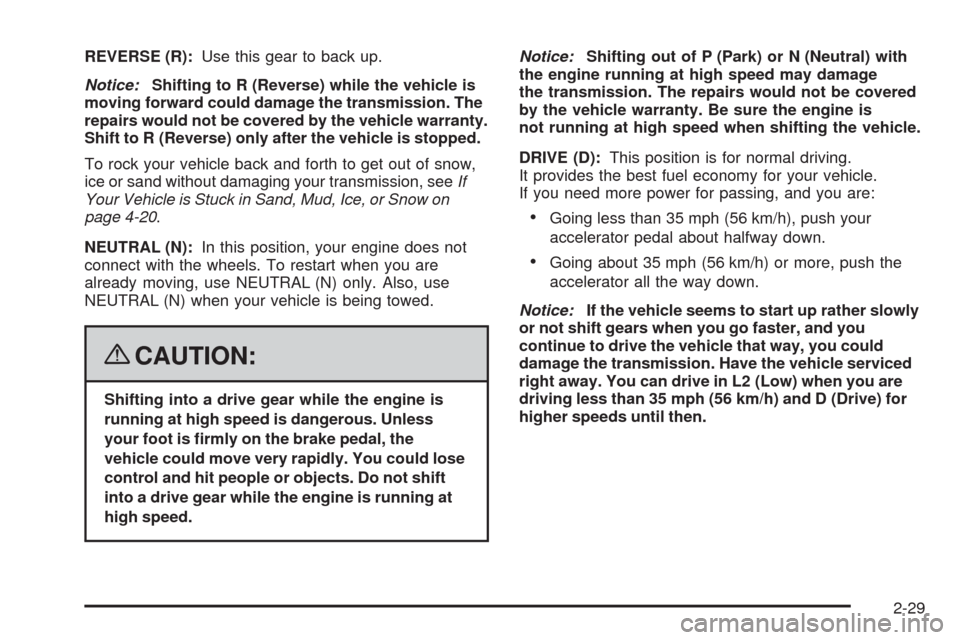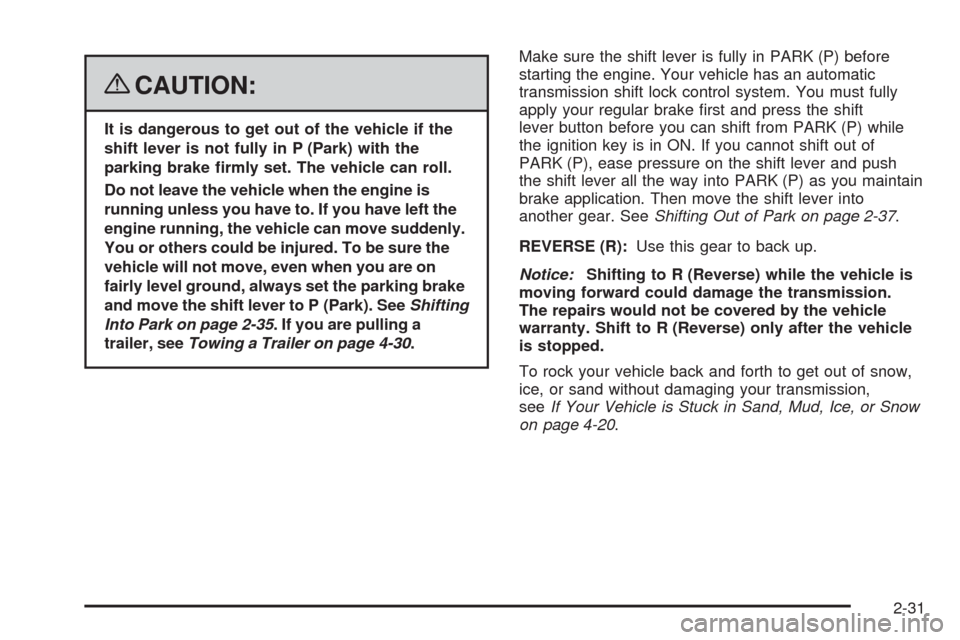2008 CHEVROLET MALIBU brake
[x] Cancel search: brakePage 79 of 412

Keys...............................................................2-3
Remote Keyless Entry (RKE) System................2-4
Remote Keyless Entry (RKE) System
Operation...................................................2-5
Remote Vehicle Start......................................2-7
Doors and Locks............................................2-10
Door Locks..................................................2-10
Power Door Locks........................................2-11
Door Ajar Reminder......................................2-11
Delayed Locking...........................................2-11
Programmable Automatic Door Locks..............2-11
Rear Door Security Locks..............................2-12
Lockout Protection........................................2-12
Trunk..........................................................2-13
Windows........................................................2-15
Power Windows............................................2-16
Sun Visors...................................................2-18
Theft-Deterrent Systems..................................2-18
Content Theft-Deterrent.................................2-18
PASS-Key
®III+ Electronic Immobilizer.............2-20
PASS-Key®III+ Electronic Immobilizer
Operation.................................................2-20Starting and Operating Your Vehicle................2-22
New Vehicle Break-In....................................2-22
Ignition Positions..........................................2-22
Retained Accessory Power (RAP)...................2-24
Starting the Engine.......................................2-24
Adjustable Throttle and Brake Pedal................2-26
Engine Coolant Heater..................................2-27
Automatic Transmission Operation
(Four Speed Transmission).........................2-28
Automatic Transmission Operation
(Six Speed Transmission)...........................2-30
Parking Brake..............................................2-34
Shifting Into Park..........................................2-35
Shifting Out of Park......................................2-37
Parking Over Things That Burn.......................2-37
Engine Exhaust............................................2-37
Running the Vehicle While Parked..................2-38
Mirrors...........................................................2-39
Manual Rearview Mirror.................................2-39
Automatic Dimming Rearview Mirror with
OnStar®and Compass...............................2-39
Outside Power Mirrors...................................2-41
Outside Automatic Dimming Mirror..................2-42
Section 2 Features and Controls
2-1
Page 89 of 412

Power Door Locks
The power door lock switches are located on the
front doors.
K(Unlock):Press to unlock the doors.
Q(Lock):Remove the key from the ignition and
press to lock the doors.
Door Ajar Reminder
If one of the doors is not fully closed while the ignition is
on and the shift lever is moved out of PARK (P) or
NEUTRAL (N) the following will occur:
A chime will sound.
The DOOR AJAR message will display through the
Driver Information Center (DIC) until the door is
closed. SeeDIC Warnings and Messages on
page 3-48.
Delayed Locking
This feature will delay the actual locking of the doors
and arming of the theft-deterrent system for �ve seconds
when the power door lock switch or remote keyless
entry transmitter is used to lock the vehicle.If any door is open when locking the vehicle,
three chimes will sound signaling that the delayed
locking feature is active. Five seconds after the
last door is closed, all of the doors will lock. To cancel
the delay and lock the doors immediately, press the lock
button on the remote keyless entry transmitter or the
power door lock switch a second time. The theft
deterrent system will arm after 30 seconds.
Programmable Automatic Door
Locks
Automatic Locking
All the doors automatically lock when the ignition is in
ON/RUN and the shift lever is moved out of PARK (P).
All doors must be closed. The automatic locking
feature cannot be disabled.
All doors will lock again when the brake pedal is
applied, a door is opened and then closed, and the
brake pedal is released.
2-11
Page 100 of 412

Starting and Operating Your
Vehicle
New Vehicle Break-In
Notice:Your vehicle does not need an elaborate
break-in. But it will perform better in the long run if
you follow these guidelines:
Do not drive at any one constant speed, fast or
slow, for the �rst 500 miles (805 km). Do not
make full-throttle starts. Avoid downshifting to
brake or slow the vehicle.
Avoid making hard stops for the �rst 200 miles
(322 km) or so. During this time the new brake
linings are not yet broken in. Hard stops
with new linings can mean premature wear and
earlier replacement. Follow this breaking-in
guideline every time you get new brake linings.
Do not tow a trailer during break-in. SeeTowing
a Trailer on page 4-30for the trailer towing
capabilities of your vehicle and more
information.
Following break-in, engine speed and load can be
gradually increased.
Ignition Positions
With the key in the ignition
switch, you can turn it to
four different positions.
In order to shift out of PARK (P), ignition must be in the
ON/RUN or ACC/ACCESSORY and the regular brake
pedal must be applied.
Notice:Using a tool to force the key from the
ignition switch could cause damage or break the
key. Use the correct key and turn the key only with
your hand. Make sure the key is in all the way. If
none of this works, then your vehicle needs service.
2-22
Page 104 of 412

Adjustable Throttle and Brake Pedal
If your vehicle has this feature, you can change the
position of the throttle and brake pedals. This feature is
designed for shorter drivers, since the pedals cannot
move farther away from the standard position, but can
move rearward for better pedal reach.
The ignition must be off or the vehicle in PARK (P) for
this feature to work. The feature will not work if your foot
is pushing on the throttle or brake pedal. Remove
your foot from the pedals and press the switch again.The switch used to adjust
the pedals is located on
the left side of the
instrument panel.
The adjustable pedal feature is meant to be used with
the adjustable seat and adjustable steering wheel
controls to reach a safe and comfortable position.
Adjust the throttle and brake pedals by pushing the right
and left arrow to move the pedals either closer or further.
2-26
Page 106 of 412

Automatic Transmission Operation
(Four Speed Transmission)
Your automatic
transmission has a shift
lever located on the
console between the seats.
PARK (P):This position locks your front wheels. It is
the best position to use when you start your engine
because your vehicle cannot move easily.
{CAUTION:
It is dangerous to get out of the vehicle if the
shift lever is not fully in P (Park) with the
parking brake �rmly set. The vehicle can roll.
Do not leave the vehicle when the engine is
running unless you have to. If you have left the
engine running, the vehicle can move suddenly.
You or others could be injured. To be sure the
vehicle will not move, even when you are on
fairly level ground, always set the parking brake
and move the shift lever to P (Park). SeeShifting
Into Park on page 2-35. If you are pulling a
trailer, seeTowing a Trailer on page 4-30.
Make sure the shift lever is fully in PARK (P) before
starting the engine. Your vehicle has an automatic
transmission shift lock control system. You must fully
apply your regular brake �rst and then press the shift
lever button before you can shift from PARK (P) when the
ignition key is in ON/RUN. If you cannot shift out of
PARK (P), ease pressure on the shift lever, then push the
shift lever all the way into PARK (P) as you maintain
brake application. Then press the shift lever button and
move the shift lever into another gear. SeeShifting Out of
Park on page 2-37.
2-28
Page 107 of 412

REVERSE (R):Use this gear to back up.
Notice:Shifting to R (Reverse) while the vehicle is
moving forward could damage the transmission. The
repairs would not be covered by the vehicle warranty.
Shift to R (Reverse) only after the vehicle is stopped.
To rock your vehicle back and forth to get out of snow,
ice or sand without damaging your transmission, seeIf
Your Vehicle is Stuck in Sand, Mud, Ice, or Snow on
page 4-20.
NEUTRAL (N):In this position, your engine does not
connect with the wheels. To restart when you are
already moving, use NEUTRAL (N) only. Also, use
NEUTRAL (N) when your vehicle is being towed.
{CAUTION:
Shifting into a drive gear while the engine is
running at high speed is dangerous. Unless
your foot is �rmly on the brake pedal, the
vehicle could move very rapidly. You could lose
control and hit people or objects. Do not shift
into a drive gear while the engine is running at
high speed.Notice:Shifting out of P (Park) or N (Neutral) with
the engine running at high speed may damage
the transmission. The repairs would not be covered
by the vehicle warranty. Be sure the engine is
not running at high speed when shifting the vehicle.
DRIVE (D):This position is for normal driving.
It provides the best fuel economy for your vehicle.
If you need more power for passing, and you are:
Going less than 35 mph (56 km/h), push your
accelerator pedal about halfway down.
Going about 35 mph (56 km/h) or more, push the
accelerator all the way down.
Notice:If the vehicle seems to start up rather slowly
or not shift gears when you go faster, and you
continue to drive the vehicle that way, you could
damage the transmission. Have the vehicle serviced
right away. You can drive in L2 (Low) when you are
driving less than 35 mph (56 km/h) and D (Drive) for
higher speeds until then.
2-29
Page 108 of 412

INTERMEDIATE (I):This position is also used for
normal driving. However, it reduces vehicle speed without
using your brakes for slight downgrades where the
vehicle would otherwise accelerate due to steepness
of grade. If constant upshifting or downshifting occurs
while driving up steep hills, this position can be used to
prevent repetitive types of shifts. You might choose
INTERMEDIATE (I) instead of DRIVE (D) when driving on
hilly, winding roads and when towing a trailer, so that
there is less shifting between gears.
LOW (L):This position gives you access to FOURTH,
THIRD, SECOND and FIRST gear ranges. This
provides more engine braking but lower fuel economy
than DRIVE (D). You can use it on very steep hills, or in
deep snow or mud. If the electronic range select is
put in LOW (L), the transmission will not shift into lower
gears until the vehicle is going slow enough.Automatic Transmission Operation
(Six Speed Transmission)
Your automatic
transmission has a shift
lever located on the
console between the seats.
PARK (P):This position locks your front wheels. It is
the best position to use when you start your engine
because your vehicle cannot move easily.
2-30
Page 109 of 412

{CAUTION:
It is dangerous to get out of the vehicle if the
shift lever is not fully in P (Park) with the
parking brake �rmly set. The vehicle can roll.
Do not leave the vehicle when the engine is
running unless you have to. If you have left the
engine running, the vehicle can move suddenly.
You or others could be injured. To be sure the
vehicle will not move, even when you are on
fairly level ground, always set the parking brake
and move the shift lever to P (Park). SeeShifting
Into Park on page 2-35. If you are pulling a
trailer, seeTowing a Trailer on page 4-30.Make sure the shift lever is fully in PARK (P) before
starting the engine. Your vehicle has an automatic
transmission shift lock control system. You must fully
apply your regular brake �rst and press the shift
lever button before you can shift from PARK (P) while
the ignition key is in ON. If you cannot shift out of
PARK (P), ease pressure on the shift lever and push
the shift lever all the way into PARK (P) as you maintain
brake application. Then move the shift lever into
another gear. SeeShifting Out of Park on page 2-37.
REVERSE (R):Use this gear to back up.
Notice:Shifting to R (Reverse) while the vehicle is
moving forward could damage the transmission.
The repairs would not be covered by the vehicle
warranty. Shift to R (Reverse) only after the vehicle
is stopped.
To rock your vehicle back and forth to get out of snow,
ice, or sand without damaging your transmission,
seeIf Your Vehicle is Stuck in Sand, Mud, Ice, or Snow
on page 4-20.
2-31